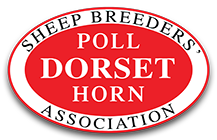1. Rams work at a younger age. The Dorset, being one of the earliest maturing breeds, will work at a younger age, hence more lambs are sired during a ram’s working life.
2. High lambing percentages. Many breeders are achieving170% lambing rates, and this coupled with a frequent lambing system of 3 crops in 2 years, can give annual averages of around 250%.
3. Faster weight gain. The ewes are excellent milkers and are thus able to achieve very quick growth rates with prime lambs being fit for the butcher at around 10 weeks of age.
4. Top prices. Lambs sired by Dorsets, both pure and crossbred, are much in demand for the quality retail trade, and found on many supermarket shelves. The carcase has a high % of lean meat required by the butcher and in the kitchen resulting in premium prices.
5. Excellent crossing ability. Dorset rams have the unique ability to sire quality prime lambs from any breed of ewe, but with the all-important asset of imparting their out-of-season breeding characteristic to their female progeny.
6. Adaptability and versatility. The Dorset is able to thrive and adjust to a wide range of conditions, both in the UK and abroad. Altitude and climatic conditions whether it be cold, high rainfall areas or drier, more arid conditions present no problem to this versatile sheep.
7. Cash savings. Lambs sold at an earlier age mean there is less valuable time spent on their management and expensive drenches, inoculations etc.
8. Higher stocking rates. As lambs are carried for a shorter time, more ewes can be run to the hectare.
9. Better workers. You need less rams in large flocks because of their ability to mate all the year round in frequent lambing systems.
10. Long life. The ewe is particularly noted for longevity, thus reducing frequent flock replacements.
